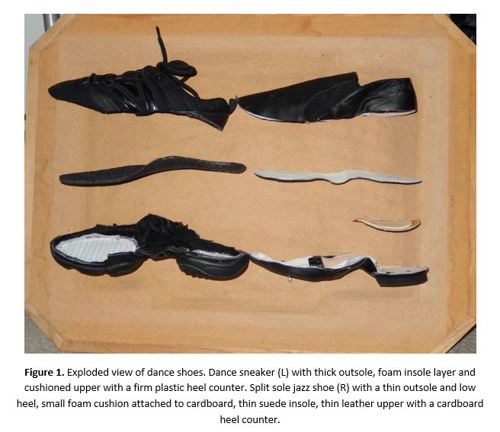If the shoe fits: Choosing the right dance shoe
Author: Alycia Fong Yan
There are a large variety of different dance shoes to choose from, but which shoe is right for you, what did your dance teacher want you to wear, what will make you look good, and does it really matter in the long run? The difference in dance performance when wearing various shoe designs is not only something many dancers have experienced, but has been measured and shown to be true. There are several factors you need to consider when choosing a dance shoe: the fit of the shoe, the genre of dance, what you want your shoe to do, and what dance steps you want to perform best.
Having a shoe that fits properly will lower the risk of injury to the lower limb. If the shoe is too big or loose the foot can move around inside the shoe, while if the shoe is too small or tight the toes can become squashed and overlap each other, potentially leading to toe and foot deformation such as bunions. Although it is tempting to buy a shoe with a bit of “growing room”, in the long term it will be a much cheaper option to get properly fitting shoes and save on the healthcare bills further down the track.
Sometimes the choice of shoe for a dance performance or examination is out of the dancer’s control; either there are regulations to follow, or the dance teacher or choreographer wants a particular look for a performance. A shoe with a thicker outsole and more rigid upper, like dance sneakers, will not allow the toes, foot or ankle to point as well as they could when barefoot [Figure 1]. Regardless of how much effort is being put into pointing the feet, if the shoe does not allow the movement, the pointed feet and ankles are not seen.

Dancers can be at risk of repetitive impact-related injuries and cushioning in the shoe may help. But don’t simply go for the shoe with the thickest sole and visible cushioning. Advances in technology have made the shock absorbing materials thinner and more effective, so the newer models will actually be more shock absorbing even if they are more streamlined.
Jumps in high heeled shoes can feel heavy and cumbersome and research has shown that jump height is reduced when wearing high heeled shoes compared to flats or bare feet. This is because the capacity for the feet and ankles to propel the dancer into the air is reduced.
Select the shoe that meets the style of dance, but know that your performance may be different from when you are dancing barefoot or in a different pair of shoes. Like any form of training, a gradual increase in exposure to new footwear will allow the body to adapt movement patterns. Rehearse in the same shoes that you will perform in as early as possible to help improve your performance and reduce the risk of injury.
Alycia Fong Yan, PhD
Exercise and Sport Science
Faculty of Health Sciences
THE UNIVERSITY OF SYDNEY
Recommended Readings
1. Fong Yan A, Hiller C, Sinclair PJ, Smith RM. Kinematic analysis of sautés in barefoot and shod conditions. J Dance Med Sci. 2014;18(4):149-58.
2. Fong Yan A, Hiller C, Smith R, Vanwanseele B. Effect of footwear on dancers: a systematic review. J Dance Med Sci. 2011;15(2):86-92.
3. Fong Yan A, Smith R, Hiller C, Sinclair P. Maximum height of a dance jump in different jazz shoes. In: Bradshaw E, Burnett A, Hume P, editors. 30th Conference of the International Society of Biomechanics in Sports; Melbourne. Australian Catholic University, Melbourne: Australian Catholic University; 2012. p. 428 - 31.
4. Fong Yan A, Smith R, Hiller C, Sinclair P. The effect of jazz shoe design on impact attenuation. Footwear Sci. 2013;5(sup1):S124-S5.
5. Fong Yan A, Smith RM, Vanwanseele B, Hiller C. Mechanics of jazz shoes and their effect on pointing in child dancers. J Appl Biomech. 2012;28(3):242-8.
6. Tuckman A, Werner F, Bayley J. Analysis of the forefoot on pointe in the ballet dancer. Foot Ankle. 1991;12(3):41-6.
7. Kravitz SR, Murgia CJ, Huber S, Fink K, Shaffer M, Varela L. Bunion deformity and the forces generated around the big toe : a biomechanical approach to analysis of pointe dance, classical ballet. In: Shell CG, editor. The Dancer as Athlete: The 1984 Olympic Scientific Congress Proceedings. Champaign, IL: Human Kinetics Publisheers, Inc.; 1986. p. 43-51.
8. Pearson SJ, Whitaker AF. Footwear in classical ballet: a study of pressure distribution and related foot injury in the adolescent dancer. J Dance Med Sci. 2012;16(2):51-6.
9. Dozzi PA, Winter DA. Biomechanical analysis of the foot during rises to full pointe : implications for injuries to the metatarsal-phalangeal joints and shoe redesign. Kinesiology and medicine for dance. 1993;16(1):1-11.